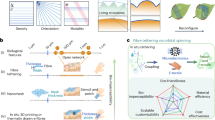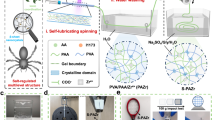Abstract
In this study, adhesive polymers were designed and synthesized using biobased compounds as building blocks. Using the Passerini three-component reaction (Passerini-3CR) as a postpolymerization modification process, photoresponsive phenylpropanoid units were introduced into biobased adhesive polymers via a one-step process that bypassed a protection-deprotection strategy. These biobased adhesive polymers showed good adhesion properties for quartz plates. Photoirradiation affected the adhesion behaviors of the polymers, probably due to the [2 + 2] self-cycloaddition of phenylpropanoid-derived vinyl moieties.
This is a preview of subscription content, access via your institution
Access options
Subscribe to this journal
Receive 12 print issues and online access
$259.00 per year
only $21.58 per issue
Buy this article
- Purchase on Springer Link
- Instant access to full article PDF
Prices may be subject to local taxes which are calculated during checkout






Similar content being viewed by others
References
Kopetz H. Renewable resources: build a biomass energy market. Nature. 2013;494:29–31. https://doi.org/10.1038/494029a.
Ragauskas AJ, Beckham GT, Biddy MJ, Chandra R, Chen F, Davis MF, et al. Lignin Valorization: Improving Lignin Processing in the Biorefinery. Science. 2014;344. https://doi.org/10.1126/science.1246843.
Rinaldi R. Plant biomass fractionation meets catalysis. Angew Chem Int Ed.2014;53:8559–60. https://doi.org/10.1002/anie.201404464.
Satoh K. Controlled/living polymerization of renewable vinyl monomers into bio-based polymers. Polym J.2015;47:527–36. https://doi.org/10.1038/pj.2015.31.
Wang S, Kesava SV, Gomez ED, Robertson ML. Sustainable thermoplastic elastomers derived from fatty acids. Macromolecules. 2013;46:7202–12. https://doi.org/10.1021/ma4011846.
Siracusa V, Blanco I. Bio-Polyethylene (Bio-PE), Bio-Polypropylene (Bio-PP) and Bio-Poly(ethylene terephthalate) (Bio-PET): Recent Developments in Bio-Based Polymers Analogous to Petroleum-Derived Ones for Packaging and Engineering Applications. Polymers. 2020;12:1641. https://doi.org/10.3390/polym12081641.
Takeshima H, Satoh K, Kamigaito M. Bio-Based Functional Styrene Monomers Derived from Naturally Occurring Ferulic Acid for Poly(vinylcatechol) and Poly(vinylguaiacol) via Controlled Radical Polymerization. Macromolecules. 2017;50:4206–16. https://doi.org/10.1021/acs.macromol.7b00970.
Heinrich LA. Future opportunities for bio-based adhesives—advantages beyond renewability. Green Chem. 2019;21:1866–88. https://doi.org/10.1039/c8gc03746a.
Ferdosian F, Pan Z, Gao G, Zhao B. Bio-based adhesives and evaluation for wood composites application. Polymers. 2017;9:70. https://doi.org/10.3390/polym9020070.
Hemmilä V, Adamopoulos S, Karlsson O, Kumar A. Development of sustainable bio-adhesives for engineered wood panels—a review. RSC Adv. 2017;7:38604–30. https://doi.org/10.1039/c7ra06598a.
Kakuchi R. The dawn of polymer chemistry based on multicomponent reactions. Polym J.2019;51:945–53. https://doi.org/10.1038/s41428-019-0209-0.
Yang B, Zhao Y, Wei Y, Fu C, Tao L. The Ugi reaction in polymer chemistry: syntheses, applications and perspectives. Polym Chem.2015;6:8233–9. https://doi.org/10.1039/C5PY01398D.
Theato P. Multi-Component and Sequential Reactions in Polymer Synthesis. P. p V–VI. https://doi.org/10.1007/978-3-319-20720-9 (Springer Cham, Switzerland, 2015).
Kakuchi R. Multicomponent reactions in polymer synthesis. Angew Chem Int Ed.2014;53:46–48. https://doi.org/10.1002/anie.201305538.
Rudick JG. Innovative macromolecular syntheses via isocyanide multicomponent reactions. J Polym Sci Part A. 2013;51:3985–91. https://doi.org/10.1002/Pola.26808.
Deng XX, Cui Y, Du FS, Li ZC. Functional highly branched polymers from multicomponent polymerization (MCP) based on the ABC type Passerini reaction. Polym Chem.2014;5:3316–20. https://doi.org/10.1039/c3py01705b.
Jee J-A, Spagnuolo LA, Rudick JG. Convergent Synthesis of Dendrimers via the Passerini Three-Component Reaction. Org Lett.2012;14:3292–5. https://doi.org/10.1021/ol301263v.
Kreye O, Tóth T, Meier MAR. Introducing Multicomponent Reactions to Polymer Science: Passerini Reactions of Renewable Monomers. J Am Chem Soc.2011;133:1790–2. https://doi.org/10.1021/ja1113003.
Deng X-X, Li L, Li Z-L, Lv A, Du F-S, Li Z-C. Sequence Regulated Poly(ester-amide)s Based on Passerini Reaction. ACS Macro Lett. 2012;1:1300–3. https://doi.org/10.1021/mz300456p.
Li L, Kan X-W, Deng X-X, Song C-C, Du F-S, Li Z-C. Simultaneous dual end-functionalization of peg via the passerini three-component reaction for the synthesis of ABC miktoarm terpolymers. J Polym Sci Part A. 2013;51:865–73. https://doi.org/10.1002/pola.26443.
Kakuchi R, Tsuji R, Fukasawa K, Yamashita S, Omichi M, Seko N. Polymers of lignin-sourced components as a facile chemical integrant for the Passerini three-component reaction. Polym J.2021;53:523–31. https://doi.org/10.1038/s41428-020-00448-w.
El-Seedi HR, El-Said AM, Khalifa SA, Goransson U, Bohlin L, Borg-Karlson AK. et al. Biosynthesis, natural sources, dietary intake, pharmacokinetic properties, and biological activities of hydroxycinnamic acids. J Agric Food Chem.2012;60:10877–95. https://doi.org/10.1021/jf301807g.
Wang SQ, Kaneko D, Kan K, Jin X, Kaneko T. Syntheses of hyperbranched liquid-crystalline biopolymers with strong adhesion from phenolic phytomonomers. Pure Appl Chem.2012;84:2559–68. https://doi.org/10.1351/Pac-Con-12-05-12.
Thi TH, Matsusaki M, Shi D, Kaneko T, Akashi M. Synthesis and properties of coumaric acid derivative homo-polymers. J Biomater Sci Polym Ed.2008;19:75–85. https://doi.org/10.1163/156856208783227668.
Takeshima H, Satoh K, Kamigaito M. Scalable Synthesis of Bio-Based Functional Styrene: Protected Vinyl Catechol from Caffeic Acid and Controlled Radical and Anionic Polymerizations Thereof. ACS Sustain Chem Eng. 2018;6:13681–6. https://doi.org/10.1021/acssuschemeng.8b04400.
Kong XZ, Xu ZF, Guan LZ, Di MW. Study on polyblending epoxy resin adhesive with lignin I-curing temperature. Int J Adhes Adhes.2014;48:75–79. https://doi.org/10.1016/j.ijadhadh.2013.09.003.
Lee H, Dellatore SM, Miller WM, Messersmith PB. Mussel-inspired surface chemistry for multifunctional coatings. Science. 2007;318:426–30. https://doi.org/10.1126/science.1147241.
Lee H, Lee BP, Messersmith PB. A reversible wet/dry adhesive inspired by mussels and geckos. Nature. 2007;448:338–41. https://doi.org/10.1038/nature05968.
Matos-Perez CR, White JD, Wilker JJ. Polymer composition and substrate influences on the adhesive bonding of a biomimetic, cross-linking polymer. J Am Chem Soc.2012;134:9498–505. https://doi.org/10.1021/ja303369p.
Hiraishi N, Kaneko D, Taira S, Wang S, Otsuki M, Tagami J. Mussel-mimetic, bioadhesive polymers from plant-derived materials. J Investig Clin Dent.2015;6:59–62. https://doi.org/10.1111/jicd.12054.
Kaneko D, Wang SQ, Matsumoto K, Kinugawa S, Yasaki K, Chi DH. et al. Mussel-mimetic strong adhesive resin from bio-base polycoumarates. Polym J.2011;43:855–8. https://doi.org/10.1038/pj.2011.77.
Wang SQ, Kitamura Y, Hiraishi N, Taira S, Tsuge A, Kaneko T. et al. Preparation of mussel-inspired biopolyester adhesive and comparative study of effects of meta- or para-hydroxyphenylpropionic acid segments on their properties. Polymer. 2019;165:152–62. https://doi.org/10.1016/j.polymer.2019.01.012.
Haddleton DM, Creed D, Griffin AC, Hoyle CE, Venkataram K. Photochemical Crosslinking of Main-Chain Liquid-Crystalline Polymers Containing Cinnamoyl Groups. Makromol Chem Rapid Commun.1989;10:391–6. https://doi.org/10.1002/marc.1989.030100803.
Tanaka H, Honda K. Photoreversible reactions of polymers containing cinnamylideneacetate derivatives and the model compounds. J Polym Sci, Polym Chem Ed.1977;15:2685–9. https://doi.org/10.1002/pol.1977.170151113.
Curme HG, Natale CC, Kelley DJ. Photosensitized Reactions of Cinnamate Esters. J Phys Chem.1967;71:767–70. https://doi.org/10.1021/j100862a046.
Wang SQ, Kaneko D, Okajima M, Yasaki K, Tateyama S, Kaneko T. Hyperbranched polycoumarates with photofunctional multiple shape memory. Angew Chem Int Ed.2013;52:11143–8. https://doi.org/10.1002/anie.201305647.
Kaneko T, Thi TH, Shi DJ, Akashi M. Environmentally degradable, high-performance thermoplastics from phenolic phytomonomers. Nat Mater.2006;5:966–70. https://doi.org/10.1038/nmat1778.
Chauzar M, Tateyama S, Ishikura T, Matsumoto K, Kaneko D, Ebitani K. et al. Hydrotalcites Catalyze the Acidolysis Polymerization of Phenolic Acid to Create Highly Heat-Resistant Bioplastics. Adv Func Mater.2012;22:3438–44. https://doi.org/10.1002/adfm.201200427.
Bazin A, Duval A, Averous L, Pollet E. Synthesis of Bio-Based Photo-Cross-Linkable Polyesters Based on Caffeic Acid through Selective Lipase-Catalyzed Polymerization. Macromolecules. 2022;55:4256–67. https://doi.org/10.1021/acs.macromol.2c00499.
Isakova A, Topham PD, Sutherland AJ. Controlled RAFT polymerization and zinc binding performance of catechol-inspired homopolymers. Macromolecules. 2014;47:2561–8. https://doi.org/10.1021/ma500336u.
Li G, Cheng G, Xue H, Chen S, Zhang F, Jiang S. Ultra low fouling zwitterionic polymers with a biomimetic adhesive group. Biomaterials. 2008;29:4592–7. https://doi.org/10.1016/j.biomaterials.2008.08.021.
Kakuchi R, Yoshida S, Sasaki T, Kanoh S, Maeda K. Multi-component post-polymerization modification reactions of polymers featuring lignin-model compounds. Polym Chem.2018;9:2109–15. https://doi.org/10.1039/C7PY01923H.
Nishimori K, Tenjimbayashi M, Naito M, Ouchi M. Alternating copolymers of vinyl catechol or vinyl phenol with alkyl maleimide for adhesive and water-repellent coating materials. ACS Appl Polym Mater.2020;2:4604–12. https://doi.org/10.1021/acsapm.0c00682.
Acknowledgements
We thank Dr. Noriaki Seko and Dr. Masaaki Omichi at the National Institutes for Quantum Science and Technology for their assistance with TG/DTA and DSC measurements.
Funding
RK gratefully acknowledges the Leading Initiative for Excellent Young Researchers and Grant-in-Aid for Scientific Research (C) (grant number: 19K05578) for financial support. RK also acknowledges the S-Membrane Project and the F-Materials Project at Gunma University for financial support.
Author information
Authors and Affiliations
Contributions
All authors contributed to the writing of the manuscript. All authors have approved the final version of the manuscript.
Corresponding author
Ethics declarations
Conflict of interest
The authors declare no competing interests.
Additional information
Publisher’s note Springer Nature remains neutral with regard to jurisdictional claims in published maps and institutional affiliations.
Supplementary information
Rights and permissions
Springer Nature or its licensor (e.g. a society or other partner) holds exclusive rights to this article under a publishing agreement with the author(s) or other rightsholder(s); author self-archiving of the accepted manuscript version of this article is solely governed by the terms of such publishing agreement and applicable law.
About this article
Cite this article
Chou, LC., Matsubara, K., Takada, K. et al. Synthesis of photoresponsive biobased adhesive polymers via the Passerini three-component reaction. Polym J 55, 1067–1074 (2023). https://doi.org/10.1038/s41428-023-00806-4
Received:
Revised:
Accepted:
Published:
Issue Date:
DOI: https://doi.org/10.1038/s41428-023-00806-4



